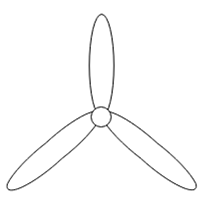This set of Food Processing Unit Operations Question Paper focuses on “Power for Agitation”.
1. Which unit operation involves the mechanically induced establishment of a flow pattern in a liquid mixture?
a) Sedimentation
b) Agitation
c) Mixing
d) Crystallization
View Answer
Explanation: Agitation is the process involving induced circular motion of homogeneous particles to prepare a liquid mixture, mechanically. Sedimentation refers to the settling down of suspension particles whereas Mixing refers to the random distribution of initially separate ingredients. Crystallization on the other hand is the formation of clumps of solid particles due to mass transfer.
2. The figure given below is a 3 bladed device, used to produce Agitation in liquids. Name it.

a) Turbine
b) Distributor
c) Blender
d) Propeller
View Answer
Explanation: The most common device used for agitation of liquids is the Propeller, which is a type of Impeller. Turbines are also a type of impellers, though with different fan orientations.
3. The role of Baffles is to improve mixing and remove stratification during agitation.
a) True
b) False
View Answer
Explanation: During the process of agitation the baffles, which are one of the mechanical agitation devices used, remove stratification in the radial direction and improve mixing performance. A typical agitator vessel setup consists of 4 baffles and 1 impeller.
4. The formula Np=\(\frac{P}{n^3Da^5\rho}\) denotes which number in impeller problems?
a) Weber number
b) Froude number
c) Power number
d) Euler Number
View Answer
Explanation: Powernumber is the ratio of inertial force to viscous force. It is dimensionless and Buckingham’s Pi theorem is applied to it, thus giving the formula Np=\(\frac{P}{n^3Da^5\rho}\) , where P is the Pressure of the liquid, n is the rotation per minute of the impeller, D is the diameter and ρ is the density of the liquid.
5. A flat blade turbine having six blades is centrally installed in a vertical tank. The tank is 6 ft (1.83 m) in diameter; the turbine is 2 ft. (0.61 m) in diameter and is positioned 2 ft (0.61 m) from the bottom of the tank. The turbine blades are 5 in. (127 mm) wide. The tank is filled to a depth of 6 ft (1.83 m) with a solution of 50 percent caustic soda, at 150°F (65.6°C), which has a viscosity of 12 cP and a density of 93.5 lb/ft3 (1498 kg/m3). The turbine is operated at 90 r/min. the tank is baffled. What power will be required to operate the mixer? (Given KL=403680).
a) 2.47 kW
b) 6.05 kW
c) 3.21 kW
d) 4.00 kW
View Answer
Explanation: First calculate Reynold’s number. We have Da = 2 ft, n =\(\frac{90}{60}\) = 1.5 r/s, μ= 12 X 6.27 X 10-4 = 8.06 X 10-3 lb/ft-s, ρ=93.5 lb/ft3 and g = 32.17 ft/s2.
NRe = \(\frac{Da^2n\rho}{μ}\) = \(\frac{2^2X1.5X93.5}{8.06 X 10^{-3}}\) = 69,600
We know that at low Reynold’s number for both baffled and unbaffled tanks, the relationship is given by
Np =\(\frac{K_L}{N_{Re}}\) = \(\frac{403680}{69600}\) = 5.8
P = \(\frac{5.8 X 93.5 X 1.5^3 X 2^2}{32.17}\)=1821 ft-lb/s
The power requirement is 1821/550 = 2.47 kW (3.31 hp).
6. Which one is not the purpose of establishment of agitation in fluids?
a) Suspension of solid particles
b) Blending of solids
c) Blending miscible liquids
d) Promoting heat transfer
View Answer
Explanation: Agitation is done to suspend solid particles that might have settled down or are not distributed throughout the fluid, for the dispersion of a gas through the liquid, for promoting heat transfer and for the blending of miscible liquids.
7. An agitator is selected depending upon the __________
a) Volume of liquid
b) Height of the tank
c) Power required
d) Fluid viscosity
View Answer
Explanation: An agitator is selected depending upon the viscosity of the fluid, since that is the only way to determine the selection from the impellers of different types. This selection is independent of fluid volume, height of the tank used, and the power required in the process.
8. Name the type of impeller used for agitation of low viscosity fluids, on high speeds?
a) Propeller
b) Concave Blade Impeller
c) Straight blade turbine
d) Paddles
View Answer
Explanation: Propellers are a type of impellers used for agitation of low viscosity fluids, on high speeds. They are effective in large vessels due to their persistence of flow currents. Paddles are used in slow or moderately sped vessels, whereas turbines are used over a wide range of viscosities.
9. Power consumption of agitators is a function of ________
a) Impeller used
b) Volumetric flow rate
c) Volumetric flow rate and Kinetic Energy
d) Kinetic Energy
View Answer
Explanation: The power consumption of agitators is a function of both, the volumetric flow rate inside the vessel and the kinetic energy. It does not depend on the type of Impeller used for the process.
10. How can swirling be prevented in agitated vessels?
a) By reducing the power provided
b) By the use of turbines
c) By the use of Baffles
d) By lowering the shaft
View Answer
Explanation: Swirling is a hinderance in agitated vessels and can be prevented by using Baffles appropriately, along with the turbines according to the viscosity of the fluid. Reducing the power in the system will only result in reducing the amount of agitation and the lowering of the shaft will result in unequal distribution of the fluid currents.
Sanfoundry Global Education & Learning Series – Food Processing Unit Operations.
To practice all questions papers on Food Processing Unit Operations, here is complete set of 1000+ Multiple Choice Questions and Answers.
If you find a mistake in question / option / answer, kindly take a screenshot and email to [email protected]
- Apply for Agricultural Engineering Internship
- Check Agricultural Engineering Books
- Check Food Processing Unit Operations Books
- Practice Agricultural Engineering MCQs
